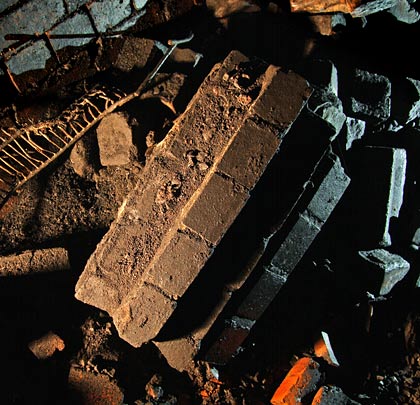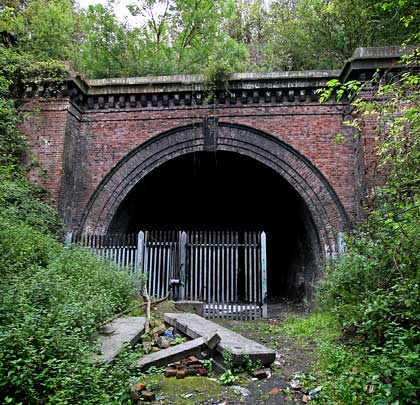Barnsdale Tunnel
Barnsdale Tunnel




























Westbound traffic on the Hull & Barnsley emerged from the 1,226-yard Barnsdale Tunnel (HBR3/132) into a sheer-sided cutting before arriving at Wrangbrook Junction, diverging point for the Wath and Denaby branches. The tunnel was driven through magnesian limestone to reach the lower beds of sandstone and clay.
Its eastern portal is found at the end of a partly-infilled cutting adjacent to the northbound service area on the A1 at Barnsdale Bar. The brickwork design is characteristic of other H&B tunnels such as Brierley and Drewton.
Inside the lining is fashioned in red brick except at the interface with the three shafts where blue brindles are used. Around 200 yards in, a 70-yard section was clearly built from an inferior batch of bricks; as a result, water ingress and freeze-thaw has caused their faces to spall. Repointing has taken place using waterproof cement, although the aesthetic quality of the work contrasts markedly with that of the tunnel’s original navvies.
Despite being generally dry, some substantial areas of calcite have built up on the walls. Clusters of weep pipes have been installed to relieve water pressure behind the lining whilst a spring emerges into the tunnel from the north wall close to the eastern end. Holes have been cut at the back of most refuges, presumably for investigation purposes.
The tunnel has three shafts – all now capped – approximately 310, 630 and 930 yards from the western entrance.
Opened on 20th July 1885, the line through the tunnel closed officially in April 1959, although there had been no regular traffic for several months prior to that. Until 1967, a set of bufferstops remained at the western entrance as part of a headshunt.
During the 1990s, following advice from consultants Brown & Root, attempts were made to seal the tunnel with concrete beams. However this barrier was attacked with industrial tools and rammed by vehicles. Eventually it was deemed to pose more of a hazard than the tunnel beyond it, and was removed. In 2010, the tunnel’s owners, British Railways Board (Residuary), erected pallisade fencing across both entrances but this too has been damaged.
The tunnel remains in a fair condition, having benefitted from patch repairs and repointing.








